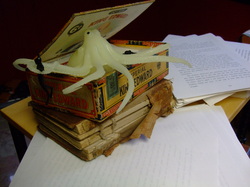

|
We gradually become historical if we live long enough, and the things everybody knows become rare and arcane. Take margarine for example. I remember as a child in the 1950s helping my grandmother clean out an old kitchen cabinet, and among the oddities in the cabinet were tiny, dusty packets of reddish-yellow dye. These, Grandma explained, were for making margarine yellow during the war, when butter was less readily available. At some point everyone must have known about this. At this point only vintage margarine-fanciers or industrial historians specializing in edible dyes are left to uphold the truth, assuming they want to. The Christmas season always includes a classic example of the way things everybody knows become things everybody forgets: the Roman census in the Gospel of Luke. Though featured on countless Christmas cards, the description of the census in Luke 2:1-7 corresponds to no known form of Roman census-taking and appears to scramble the reigns of two different governors. Maybe the Gospel writer mainly intended this to be a metaphorical account, but the simpler reading is that the writer no longer remembered what everybody used to know--how Roman administration worked in the old days before the revolt. This would be like us forgetting how the I.R.S. works or what a W-2 is, but our descendents will in fact not know about those things someday because nothing is forever, not even death and taxes. In this sense Luke 2:1-7 has great lessons for writers. The lessons are, first, we've forgotten more than we probably ever knew in the first place, and second, come to think of it, not many people notice or care very much. Such lessons are on my mind lately because I'm working on an old novel that I started in 1971. It's older than some cuneiform, I believe, but it wasn't always old. In its original form it was a day-by-day account of some events in 1970-1971. It was then called Fission and I finished the first complete draft, a novelette maybe 79 pages long, in 1975, I believe. The second complete draft, which I renamed Astral Bodies, was about 130 pages long, and I must have finished it in the very early 1980s although I don't have any actual memory of that. I do remember that I submitted it to various publishers, which involved making copies, stuffing envelopes, adding stamps, but I have no recollection of the precise details--like Roman taxation, it's a little hard to reconstruct the ancient ways.  In the years since, I assumed that somewhere around here was an old cigar box with my archives in it and among the precious litter inside there would be Astral Bodies, like a time capsule I'd left for myself to find and marvel at in a later age of the world. Earlier this year I decided to look and see, and what I found instead was a single typed copy of Astral Bodies that was 285 pages long, secured in a Japanese manuscript protector by a rotten rubber band, along with a copy of my submission letter to Ballantine Books dated 1985. This was twice as long as the draft I remembered and of inexplicable date. Also, horribly, it wasn't very good; I would say my thirty something self, who wrote the 1985 version, must have been deliberately trying to lengthen the book, always a bad idea. The primary or time-capsule draft I had wanted to see appeared to be as nonexistent as the first draft of Luke’s Gospel. I emailed some folks about this and my son Alex replied that he had what might be a different draft. He located his and sent it to me. Going by the Cottonwood Avenue address on the title page, this was a 1987 draft and it had been significantly rewritten since 1985. Odd as it was to realize that I had redrafted a novel (and submitted it for publication) and then completely forgotten that I had done so, it was even odder to discover that I had done that twice--with the same novel. I remain slightly disappointed. I would have liked to see the old 1970s version, which I had pounded out manually on a lovely antique (well, actually new then) baby blue Hermes typewriter with a French keyboard whose first row had AZERTY instead of QWERTY. So I haven't forgotten everything. But, like Lincoln's corpse, I guess the original draft now belongs to the ages.  I am now in the process of rewriting Astral Bodies as a historical novel. I don't know about the title, it sounds a little British somehow, and I can’t remember how I came by it. I may ultimately find a different one. This workable draft is awash with details of the early seventies, most of which I derived from being there. The world I’m describing is different from the popular images of the seventies we have in 2013. In some ways we know more now. In some ways what we think we know is sure to be wrong. Meanwhile, I find myself facing the paradox of my own faulty memory. I still remember Nixon's Cambodia speech but in my modern memory he uses a pointer with the famous map. In Astral Bodies he taps the map with his hand. And was there really a Bewitched rerun on TV before the Cambodia address to the nation? I will have to go to the library hat in hand and dive through the microfiche to find out whether that was witness or invention. If I had managed to retain the 1970's eyewitness draft, I think I would have had to keep faith with it. I would have owed primacy to the first account, and perhaps I could even have glimpsed my own lost self of that bygone time: reckless, impulsive, arrogant, cruel, like a Mr. Rochester without the dog, the horse, Thornton Hall, any money, any past, or any secrets; or like a Heathcliff who just would not shut up. Instead, in unearthing my eighties drafts I found relicts of a self ten years on from then, an optimistic, foolish, crafty, not too bright father of four. Not who I was looking for at all.
4 Comments
Last week's blog about slough oysters asserted that they need no recipe beyond "steam or broil." I am a little afraid these years to eat them raw, walrus-and-carpenter style. But some suggest a recipe would be welcome. So here is the basic mid-Atlantic oyster soup, which is at its best with slough oysters because of the odd little crabs that share the shell with the host oyster. First, open your oysters. Oysters have a weaker hinge than many shellfish and the hinge has a particularly weak spot, so a blunt short-bladed heavy oyster knife and a pair of utility gloves, and a little experimentation, will make you an expert pretty soon. Dump the oyster, its liquor or juice, and the nearly translucent crab which we hope will also be present, into a bowl. Repeat 12 times. You now have a dozen oysters and hopefully nearly as many miniature slough crabs in the bowl. Now put 1 cup of milk, 1/2 cup of half-and-half or cream, and a pat of butter in a pot on low heat. Add a couple of shakes of salt and a couple of grinds of black pepper, and your shucked slough oysters. Turn the heat to medium and wait for the milk to start steaming. The only complexity to this recipe is the need to keep the milk from boiling. Boiling will scald the milk and cut back sharply on the flavor. The cook has to watch the pot slowly reach a steaming heat. When it is apparent that the pot will boil in just another minute or two, and the crabs have turned pink, and the oysters are now firm, it is done. Serves two. Eat at once. Some people put oyster crackers into this. No harm done. This recipe works equally well if you just have regular non-slough oysters, but it is more entertaining and even tastier with little pink crabs in it. Winter comes and goes around here. It has been reasonably cold or at least chilly for a few weeks but yesterday the temperature shot into the 60s F, and should reach 70 F or higher today. This caused high winds and then a torrential warm rain this morning. Things are warm, gray and soggy now. It could almost be summer. I used yesterday's glorious weather to resume the rockwork in the new rock garden. The rock I had to work with was mostly Catoctin-type greenstone from Albemarle. When this rock first flowed out as lava from volcanoes probably very similar to Mauna Loa or Kilauea it would have been a magnificent building stone, had any building been on the agenda 600,000,000 years ago. That's actually just a rough date. Individual rocks may vary and continents may settle during shipping. 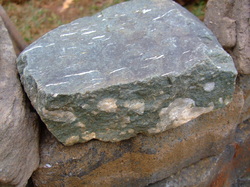 Unfortunately for my wall project, the ancestral Catoctin or Blue Ridge basalt was buried, heated and compressed into amazingly dense metamorphic greenstone. Sometimes you can see the original bedding and sometimes a bit of this rock will split out into nice flat slabs or blocks, but for the most part it comes in big irregular chunks that weigh too much and do not really stack well. My walls made out of this rock tend to have a roughly triangular cross section with a row of three rocks, then a row of two, then a top row. This produces a low, rough wall composed of irregularly-shaped chunks. There's just a hint of the original topography left in this rock. The original lava flows from the volcanoes that produced them were irregular and intermittent, and between flows lakes would have formed with sedimentary runoff, so there are pockets of mineral variation in the metamorphosed greenstone, including silica in the form of quartz among other things. This photo shows a square block of the stuff. On the front face you can see disks of white silica and on the top face you see more silica disks end-on, appearing as white streaks. These coastal volcanoes faced an ocean called Iapetus. Iapetus was then in the condition of opening up, or widening, and had we been there giving directions we would have briefly said Iapetus was to the east just before we suffocated in the unbreathable air. Philosophically there may only ever have been one ocean, but we find it useful and rational to refer to an Atlantic and a Pacific, and ancestral oceans also need names, although the exact shape and nature of Iapetus is something yet to be argued out. 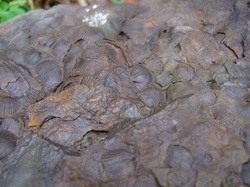 A lot of the rocks in the walls in our yard are now in at least their third different wall, since I like to upgrade my walls when economics allows. They've been hauled around the yard more than once and will probably be moved again into yet another wall someday when I improve this garden that I am now in the process of building. So I find among these mixed-up reused rocks evidence of yet another sea, the Appalachian Basin. This Devonian seaway produces dates in the 380-million-year range. In this era the Iapetus Ocean was closing up and our former east-coast location had become a west-coast location. Here is a photo of a rock I like to use as a top rock on various of my garden walls. As can be seen, shells had very much come into their own when this rock was formed. The sea shells of that era tend to be smaller than modern shells, and to be brachiopods rather than mollusks, although mollusks in the form of small clams were also abundant, as were the ancestors of squids and octopi. But I digress. 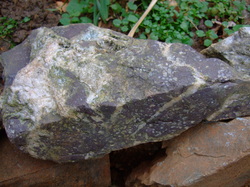 Back to our suite of greenstone-associated rocks, here is a rock I gathered from a Blue Ridge creek feeding a nearby reservoir. The blowout from the creek had plenty of greenstone but the cross section included the rock under the greenstone, the granite of an old continental shield a billion years old, making our greenstones seem less archaic than they look after all. It also included these blocks of porphyry, which on a gray day like today photographed rather plain. In sunlight these are a rich purple. In terms of the rocks mentioned so far the porphyry slabs are practically youngsters. I am informed these porphyries intruded into the old Precambrian layers as recently as a mere 60 million years ago, in round numbers, which no longer seems so very old after all. They say time goes by faster and faster as we age. I remember the days when I used to look at rocks and fossils and think of them as ancient things, almost incalculably ancient, but now they seem like the companions of my youth. They are somewhat older than me, but that no longer seems very important now. 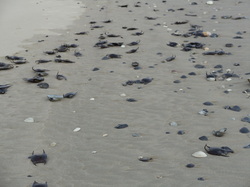 The beach in winter somehow seems more intimate with the ocean. Often there isn't anyone there. You may see another set of footprints from a shell hunter; or you might take another walk in the afternoon and see only your own footprints from the morning. Things only speak if you listen and sometimes you can only listen properly alone. The ocean itself is a presence not easy to describe; it is alive, active, mercurial; it has amazing properties of light. The things the ocean casts up seem like pieces of story. They may have been alive this morning. They may still be alive. Or the sea might have held them in trust for years or centuries, perhaps intact or perhaps re-worked, maybe to the point where identification is hard. Why would an infant's plastic pacifier, unscarred and plainly as recent as this summer, wash up next to a dead shark three feet long? The leopardskin-patterned ear piece of a pair of sunglasses--was it lost here? Has it traveled hundreds of miles? On the Outer Banks of the Carolinas, the famous Graveyard of the Atlantic, the winter wrack generally includes pieces of bunker coal from shipwrecks. Clinkers from the boilers of these ships are slightly rarer. Scraps of metal plating, well rusted, are still common although fewer and fewer ships go down all the time, probably because there are fewer and fewer ships. There are more seashells in the winter, because there are fewer people picking seashells up. There is less trash because there are fewer people. What looks like a wedge of black pie turns out to be a triangular section of intervertebral disk from a Miocene whale-like mammal 20 million years old -- it's a fossil bone, most probably from the Yorktown Formation and carried down the coast by the inshore current. This was a big one, original diameter 8 inches. Not far away is a piece of petrified cypress wood from the same formation, from the swamps of a previous coastline now many miles inland. Mixed with this sort of thing are fresh shells, and very worn modern shells that, modern though they may be, are still a thousand years old. Not to mention any number of black skate egg cases. 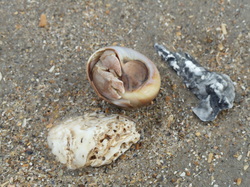 And living creatures. I'm very fond of moon shells, the well known univalve gastropod mollusk. We could throw other words at it. The moon shell is many things to many creatures. Hermit crabs also love them. They creep inside and cover up with their claws. Here's one with a hermit crab--I threw this one back into the sea before the gulls got it. 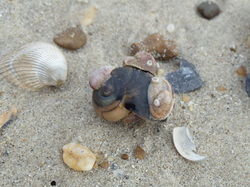 Slipper shells also love empty moon shells. By slipper shell I mean Crepidula fornicata, and I don't even want to know what it did to earn that name. It reminds me too much of the joke about Murphy the clock-mender. Actually, we do want to know why they are called that. The answer is that this filter-feeding gastropod mollusk, a type of limpet, likes to stack up. All of them start as males but when they start stacking up on each other, the ones on the bottom turn into females. They do not have any known religion. 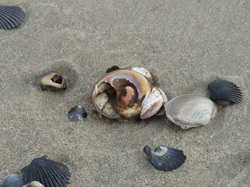 These were pretty common on the beach last week. I threw them back into the sea too. There's some ironic justice to the re-use of moon shells since the moon creatures themselves are predators who drill holes in the shells of other animals and slurp them out. They have a hydraulically powerful foot that can get under the sand, inflate itself like a high-pressure sucker, and haul up buried bivalves, which they then attach and drill into using their tongue. They wind up eating a certain amount of shell before getting to the prey animal itself but since they're shelled creatures, they have exceptional dietary calcium needs anyway. They are particularly fond of razor clams, which have a delightfully thin and crunchy shell. For more on moon shells, see http://oceanica.cofc.edu/shellguide/shells/moonsnail.htm 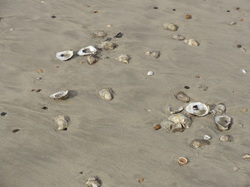 Before we criticize the moon creatures (Neverita duplicata) for wolfing down bivalves, we should consider that on our beach trip last week, it only took four people two days to eat half a bushel of fresh oysters and throw the shells back onto the beach. The miracle is that we did not eat two bushels. Here is a picture of our dinner after we threw it back, minus the oyster contents. And speaking of things living inside the shells of other things, most of the oysters in our half-bushel contained the commensal crab, Zaops ostreus, which lives inside the oyster's gills and shares its food without prejudice to either animal. These are locally called crab slough oysters. The ignorant may view this as a very dubious thing to eat but take my gustatory word for it, these weird little crabs are something to celebrate. No recipe is needed for preparing them. We steamed ours, but otherwise basically ate them the way nature presented them, like the moon snails do. See http://en.wikipedia.org/wiki/Oyster_crab 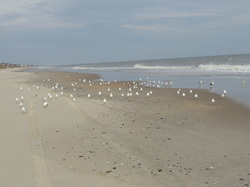 For many years we've had a "guys' winter fishing trip" on the Outer Banks of North Carolina. We actually always invite every woman we know but since none ever show up it remains a guys' trip. This began decades ago as a real fishing trip in which fish were actively hunted for meat despite the possibility of horrific cold and savage unrelenting wind. Over the years it evolved into a threatening-to-fish trip, where we would display or rattle our fishing gear and openly threaten to use it. Then it became a trip of fishing reminiscence, where we reminisced about fishing. The next stage in the devolution of this experience was threatening to reminisce about fishing, where younger members of the party (those under 60) were taunted with threats to tell all about certain long-dead fish whose bizarre fate was to be among the very few fish ever caught by anyone we knew personally. Eventually this threat became meaningless. Our memory of these luckless individuals has become vague. Others remain committed. We saw evidence of this yesterday morning from the upper deck of the oceanfront house we rented this year in Corolla. A distinctly cold rain slanted in, driven by winds strong enough to blow the seashells off the porch and turn the deck chairs over. The storm-furrows of the gray-green Atlantic piled wave on foaming wave against the beach. Somehow there was a fishing boat out in this, not much more than 300 yards off the beach, bucking up and down like a ride in an amusement park, although I doubt amusement was a widespread emotion on the boat. The stern would ride up and the bow would plunge under and then the reverse would happen, the bow would rise up and pour water the length of the boat with a "Here, drink this" motion while the stern went under. Of course boats in these circumstances also wallow from side to side like a hog in mud, making seasickness a real possibility. We wondered if this would have been safer or less safe if the boat had been slightly larger or slightly farther off the famous ship-eating sandbanks. We wondered why they were motoring north against the wind, when this plainly resulted in barely any headway. "Of course fishermen around here are practically born doing this sort of thing. They'd never stay home under these conditions. They probably can't wait to get out there and fish right off the beach in the worst storm of the year so far." This ridiculous theory was dismissed immediately. Even Jason and the Argonauts couldn't get a hook into the water under these conditions. Binoculars revealed no signs of humans on board, suggesting everyone had long since been swept off into the sea. However, someone was plainly steering this vessel; otherwise it would have already been up in the dunes like many a bad idea before it. The survivors had probably all lashed themselves to the railings -- it's practically traditional. The explanation, I am sure, was less fanciful. This was probably a charter. Now see here, Cap'n Bob, today is Saturday and I paid some crazy amount of money to go fishing, so me and the guys are going fishing or I will have my deposit back and leave scathing comments on the internet. Aaarh, then. Anything you say, matey. Pile aboard, me buckos. It took the Flying Dutchman most of an hour to slug past the house through the breakers. I imagine the trip back south went much faster. They were probably fishing for adjectives. Some of the wildest and rarest strings of adjectives in any language would be caught under just these conditions. 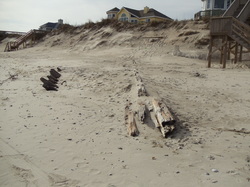 The Outer Banks have their own weather. The day before was a sunny 70+ degrees and perfect for beach strolling. I had the beach largely to myself. There are few people out there in December. Once or twice I saw distant shapes representing other people, at least a mile from where I was. And I found a shipwreck. This was like old times. I first visited the Outer Banks as a small child in 1956 and have seen a lot of it over the years since. In my childhood, and at least as recently as the 1970s, bits of ships were scarcely rare, probably better described as common, on these beaches. With the passage of time, with salvage and vandalism, and since there are fewer and fewer shipwrecks these days, demand has come to exceed supply by quite a lot, and the rare remnants of shipwrecks are about all there is to see today. But once in a while a great storm will excavate or drive ashore the moldering hulk of some past disaster, as in the case of this old schooner. 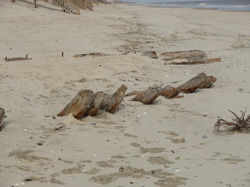 This would have been a very ordinary sort of commercial cargo carrier of the 1870s. Here it is on the beach, officially labeled as "unknown vessel." As David Stick pointed out in Graveyard of the Atlantic, “The bare ribbed skeletons of countless ships are buried there; some covered only by water…others burrowed deep in the sands.” 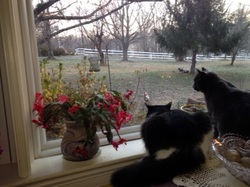 Karen took this picture of our cats Treena and Sheena next to an heirloom epiphyte, Schlumbergera orssichiana, or "Christmas cactus", and posted the photo as "Cats and Cactus," which sounds somehow late D. H. Lawrence in flavor. It's not a very large cactus but it is many years old, and belonged to Karen’s late mother. Treena and Sheena are house cats exclusively though they do enjoy our screened porch where they spend whole days in fine weather. Their feelings about the outside are conflicted. Treena will make a break for it but if she succeeds in escaping she just runs in circles in the yard. Not really a good Darwinian adaptation. Sheena used to be tempted to escape too, but on one occasion she succeeded too well and had to spend a couple of hours sitting on the stoop waiting to be let back in. Since then, the outdoors is not for her. Sheena is a shorthair and doesn't even care for the porch in cold weather. Treena, on the other hand, has a psychopathic degree of optimism about all things. She scratches to be let onto the porch regardless of weather. If the porch is as cold as it is today, she scratches to be let back in after about three minutes. An hour later she's ready to try again. It could have gotten warm. She won't know until she tries. In her experience sometimes it's warm and sometimes it's cold and she may see no pattern in this -- or she may just be playing. 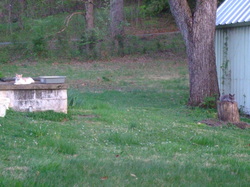 Our country neighborhood, which is well forested and has large yards, is home to a varying number of feral and semi-feral cats. This photo, taken several summers ago, captures a couple of them sunning in the side yard. The ferals love our sheds and brush pile, and live under and in these, and they hunt. In winter, regardless of cold, perhaps especially when it's good and chilly, they hunt for a good part of the day, or just prowl for snacks. Their coats become very glossy and wooly as if stimulated by cold. We just know them by their colors -- the long-haired gray one, the black and white one, the tabby colored one. Some establish a more definite identity. A few years ago I found a mass of tufted orange and white hair on the rockpile with a cat collar marked "Biskkit" and an address in town about 5 miles from here. It sounds gruesome to say so but I interpreted this as the work of buzzards, who will carry a dead animal to a convenient place to pluck it. So I disposed of Biskkit's identification and wrote him off as a case of vulture-absconded roadkill of whom nothing was left but his collar. A couple of days later we began to spot a huge dreamsicle-colored tom with a white and orange ruff that exactly matched the tufts on the rockpile. It was Biskkit. Had I kept his I.D. I could have sent him home. But he didn't want to be home. He had apparently removed his own collar by rubbing it off over his head. Was he a dropped cat or a volunteer feral? I don't know, but he was great at yard life. Also rude; he was a rude and unmannerly animal with a nasty attitude and he probably always belonged outdoors. In cat language his name was surely not Biskkit but something like Hiss-spitter. We saw Biskkit prowling the area fat and sleek for the next three or four years, which is half a life cycle for a feral cat. The yard ferals were fascinated by the fox that appeared in our yard two days ago, on Thanksgiving morning. Though it doesn't sound festive, I had a spot of work to do and there was no reason not to do it then, but I happened to look up from the keyboard and saw movement in the woods on the hill behind the house. It was a big red fox of the classic fairy tale variety, as large as a hunting dog. Unlike the somewhat meandering paths feral cats often take, the fox moved as if it had somewhere to be -- a trotting gait in a straight line across the face of the hill. Foxes do seem sometimes to have a purposefulness to them. Last summer we saw a smaller one trotting up the center of the road in broad daylight without an apparent care in the world. And why should they not. Not long after, I spotted the white and black feral and the longhaired gray feral heading up the hill from opposite sides of the yard, like they were on a flanking maneuver. In reality I think they just wanted to smell the fox trail. Cats and foxes interest each other though a fox can't catch a cat and a cat has no reason to catch a fox. It was an interesting moment in their day. It was an interesting moment in my day. Treena and Sheena missed it. They were glued to the front window on the other side of the house, absolutely hypnotized by the assortment of small and large birds flitting to and fro on the bird feeder. One thinks of Svengali as catlike, hypnotizing the more birdlike Trilby; but it is the cat Svengalis who seem to pass into some altered consciousness at the window, while the birds see only their own reflections and not the gnashing teeth behind the glass.
|
AuthorGary Dale Mawyer, a Central Virginia native, has over 40 years of publishing and editing experience and lives with his wife Karen and two cats in Albemarle County. Sites I likeafroculinaria.com/
largea.wordpress.com/livinglisteningandthingsilove naturalpresencearts.com/ someperfectfuture.com Archives
July 2024
|